Italian Ways Read online
Page 8
But what really makes the Eurostar a nightmare is also its greatest claim to being serious and European, which is to say, un-Italian: as the sleek green-and-white bands slither and hiss into the station, that ubiquitous metallic voice is already announcing. EUROSTAR! – Novemiladuecentotrentasette – per – TORINO PORTA NUOVA – è – in partenza dal binario – sei – PRENOTAZIONE OBBLIGATORIA!
Prenotazione obbligatoria. The Eurostar is a reserved-seats-only train. You have to book. The idea behind this was that never again would the moneyed traveller find himself having to stand up on his long journey between the Milan stock exchange and Rome’s tortuous corridors of power; never again would a Friday evening through the tunnels of the Apennines remind one of the Milan metro in the rush hour, something that can very easily happen on an Intercity, even in the first class. No, for the Eurostar – a train of such beauty, of such speed, of such thrusting, long-distance purpose – a reservation would be absolutely obligatory. Away with the riff-raff and their Interregionale tickets trying to muscle on at the last minute and buy supplements aboard. Eurostar journeys are serious matters for serious people.
Of course, there are loopholes.
‘Please, please, Signor Capotreno’ – a man with a pink tie comes panting along the platform – ‘let me get on the train.’
The capotreno shakes his head. ‘This is a reservations-only train, signore.’
‘I know. But I’ve got an Intercity supplement.’
‘I’m afraid you need a Eurostar reservation.’
‘I know, but I wasn’t sure at the time I bought the ticket when I’d be travelling. I thought I’d be in the station earlier. Per favore. I really need to catch this train now.’
Overweight, harassed, reading glasses on a string around his neck, a green cap on his head, the capotreno is striding down the side of his shiny train, trailing behind him the smart trolley bag that all capotreni travel with.
‘Per favore,’ the pink tie insists, ‘it’s my niece’s first communion.’
‘Un momento,’ the capotreno finally says. He stops and looks at the man. No doubt he’s heard the first-communion story before. He purses his lips. ‘Just one place?’ he asks.
The capotreno caves in. The man climbs on. Inside, the corridors are chaos. Those who got on at the beginning of the journey, when the train was empty, have of course sat exactly where they wanted to sit, understandably choosing places far away from screaming babies and adolescents playing with the ringtones on their Nokias. But now that the train is filling, new arrivals come along and demand the places indicated on their bookings, so the people who were seated are getting up and heading off down the narrow aisle only to find that their proper places too have been taken. Someone else has to be moved. Luggage has to be pulled down from the strangely ungenerous rack. There’s an interminable milling and pushing. Finally, the determined traveller will find that two-thirds of the way down the train there are carriages that haven’t been booked at all, they are almost completely empty. The Trenitalia computer must book up the train a section at a time.
Perhaps the only real advantage of the Eurostar is its dining car. Often when the train is packed, this is the best place to sit and work with a little elbow room, though, of course, you have to buy a coffee if you want to sit. So one evening, harassed by the beep of a Game Boy, I head for the dining car and queue up at the bar where an elderly barista with the obligatory white hat on is taking far too long to make two cappuccini. Why? He has a nice Gaggia for producing coffee and and steaming milk. What’s the problem? Then I realise that he is preparing the milk, not in a jug for five or six coffees, but cappuccino by cappuccino in a paper cup. First he puts a shot of espresso in one cup. Then he pours a little cold milk into another, and holds it under the steam nozzle. He’s taking forever. Finally I get in my order and he starts the process again, working silently, carefully, intensely.
‘Slow business,’ I eventually put it to him, ‘to make the foam separately for each coffee in a paper cup.’
The machine is quite low, obliging him to bend. He lifts a grey eyebrow in my direction. ‘Eh sì, signore!’ he says.
‘Not the normal way,’ I remark.
Patiently measuring milk into a paper cup, he shakes his head. ‘Eh no, signore!’
I wait. He holds the cup under the steam nozzle and starts to froth it. He turns the steam off, examines the froth, turns the steam on again.
‘The normal thing would be to use a bricco,’ he says, as if talking to the machine. A jug.
‘That’s right,’ I agree.
Satisfied that he has the milk just so, he tilts the cup so that the liquid and froth pour out in a slow trickle into the other paper cup, where the coffee is waiting.
‘With a bricco,’ he goes on, ‘you can make froth for ten cups at once.’
‘I imagine you can,’ I agree.
Finally, putting one of the two cappuccini I’ve ordered in front of me, he looks me in the eye: ‘Ma qua, il bricco manca.’ Which is as much as to say: here there are no jugs.
‘They haven’t given you a jug?’
‘No, signore,’ and he repeats, ‘Qua, il bricco manca.’
‘But why not? How can you make all these cappuccini without a jug?’
Now he is working with the next paper cup, his eye measuring the milk again. There is something wonderfully professional and stubborn about everything he does.
‘You ask them. They won’t tell me.’
‘Everybody knows you need a jug to froth milk.’
‘sì, signore.’
‘They certainly have money for other things.’
‘They have so much money they are arrogant.’ He is talking to his machine again. It’s as if I were overhearing his complaints, quite by chance. ‘They grow arrogant. They spend money on this, money on that, ma qua, il bricco manca. No jug. No, signore.’
As he finally puts the two cappuccini on the bar, I tell him, ‘At that point, you might as well bring a jug from home.’
For some reason the remark trips a switch. This man, who had been so determinedly taciturn and wry, is suddenly furious: ‘From home! From home! At that point I might as well bring everything from home. Everything! Capisce, signore. Qua manca tutto! We have nothing.’
He seems to be asking me to attribute a metaphysical significance to the statement.
‘They give us nothing,’ he repeats. ‘We’re not in a position to work with dignity. Una vergogna!’
Disturbed by the negative energy I have stirred up, I pay quickly and head for a table, where I’m struck by the fact that it boasts a carnation. I touch it. Yes, it’s a real flower! Where the table meets the wall under the window there’s an elaborately designed squiggle of chromed steel, which serves as a flower holder. Every table has one, and every holder holds a flower. It suggests an interesting hierarchy of values in the purchasing department at Trenitalia headquarters. Jug or no jug, the Eurostar must maintain a pretence to elegance.
BUT ASSUMING IT FITS in with your timetable, the best trains to travel on, for comfort and atmosphere, are the old Intercities, with compartments. In Milan it’s wise to walk to the very front of the train, which will be emptier, since most people are just too lazy to go so far. You climb up the steps (I like this old-fashioned business of climbing up three or four steps; it gives you the impression you really are boarding the Leonardo da Vinci), and walk along the corridor in search of the perfect seat.
The compartments have glass screens and doors. You move along looking for an empty one. People who don’t want you to intrude on their privacy tend to sit right by the door to the compartment, as if blocking the way. These people are practised travellers. They are thinking about the psychology of the person choosing his compartment, his desire to see emptiness and a way in, not a guardian at the door, as it were. German backpackers, on the other hand, need only push up all the armrests, take off their shoes and lie across the three seats with their stinking socks on display. Who would dream of joining
them?
Many Italian families find themselves overwhelmed by pangs of hunger as soon as they are safely ensconced in a compartment and immediately start a picnic. There will be the noise of crackling paper and the heavy smells of prosciutto and Gorgonzola. If it is a southern family they will try to press the food on you too and seem mildly offended if you don’t accept something. In these circumstances it is almost impossible to feel at ease.
Sometimes you’ll find that the ochre curtains have been drawn across the glass door so that you can’t see inside the compartment from the corridor. All the compartments have these curtains, a strangely civilised touch in our stripped-down, utilitarian world, but irritating when you’re out in the corridor and all the other compartments are occupied, or even packed. Why are the curtains drawn? you wonder. There’s no low sunshine to irritate anyone. It’s hardly an hour for sleeping.
In the past I didn’t have the courage to open a door covered by curtains. I had too much respect. Now I hardly think twice. I push through the curtains and more often than not find a teenager, alone, with his Discman in his ears and his feet up on the seat, or a middle-aged businessman studying his financial newspaper. The teenager will pull himself together a little shamefacedly, as if caught masturbating. The businessman is annoyed that you’ve had the impertinence to catch him hogging the place to himself.
But on more than one occasion I have stepped through the curtains to find couples in various states of undress, in which case it’s my turn to apologise. The desire for intimacy does seem the only good reason for drawing the curtains. I’ve often thought the railways could earn some useful extra money by selling special supplements that would allow people to have a locked compartment where they could make love during their journey. Recently a ticket inspector of the pignolo variety, finding a couple having sex behind drawn curtains, reported them to the on-board police for acts of indecency in a public place. This was particularly unkind because they were married, but not to each other. There have been other stories, however, of ticket inspectors of the furbo variety supplying travellers with prostitutes and guarding their privacy for the duration of the service. It’s hard to decide which kind of behaviour is more regrettable.
One person who never has any qualms about opening those ochre curtains is the minibar man, though he is not as dangerous to lovers as the ticket inspector because his arrival will be announced from afar by nasal yells of ‘Minibaar! MINIBAAAAAR!’ and the tinkling of a little bell of the kind you use on bicycles. For in the end the pompously announced servizio di minibar a bordo is nothing more than a clunkily old-fashioned refreshments cart squeaking along on big wheels with metal spokes and solid white tyres. At the front there’s a foot that the cart rests on when stationary. The base is bright red, then there are transparent plastic sides allowing you to see a small collection of snacks and drinks, including beers. On top is a steaming metal urn with a little tap at the bottom.
It’s always unwise to buy food from the minibar. The sandwiches in particular are as near to tasting of polystyrene as bread and cheese ever can or will. It’s unwise to buy the coffee, too. But from time to time, without really knowing why, I do. A mood catches me. He slides back the compartment door, still yelling ‘Minibar!’ I nod my head to tell him he has a customer.
‘Espresso?’
The young man pulls a tiny plastic cup from a long polyethylene bag. It’s the kind of cup they use to bring you pills in hospital. He rips open a packet, pours in a powder and opens the tap of his hot-water urn. Obviously he has repeated these movements so often that they have taken on a kind of conjuring-trick swiftness. Italians love to show off these unexpected dexterities, like the barmen in Milan who always send a little Campari bottle spinning in the air before catching and opening it in a single move. Some can spin and catch two simultaneously.
I am handed the tiny cup together with a little plastic envelope containing a napkin, sugar, a non-fattening sweetener, powdered milk and a stirrer. Finally there is a small square of blue paper, which is my receipt. The boy has five or six little blocks of these differently coloured papers cunningly attached to the handlebar of the cart, and for each sale – coffee, biscuits, sandwiches, beer – he must tear off a different-coloured receipt and give it to the customer.
Once, when the minibar boy saw me promptly dump my receipt in the ashtray, he warned me that I was legally obliged to retain it for the duration of my journey, as if it was a sort of ticket without which my digestive processes might be subject to sanction. If the capotreno, or the Fiamme Gialle, the tax police, he explained, ran a surprise check on the train, it was important that they find that the minibar operator was giving receipts. Otherwise he might just be taking the money and pocketing it – for the coffee, for example – perhaps charging me a bit less so that I came in on the deal. Or he could be serving friends for free. Anyway, it was my legal responsibility, he said, to keep my receipt and be ready to demonstrate that such corruption wasn’t taking place.
I confessed to him that I had never thought of this, though at a price of €1 this thimbleful of instant coffee is so expensive I can imagine some people wanting to pay a great deal less. At the end of his working day, the solemn boy went on, the number of coloured receipts handed out had to correspond to the quantity of goods sold and the amount of money taken. For example, the plastic envelopes containing sugar, stirrer and powdered milk all had to be accounted for. He couldn’t just give a plastic teaspoon, for example, to someone who wanted it for a yogurt she had brought from home! People were always asking him, the boy complained, without having any idea of the constraints he was working under. He spoke as though he were running a major department store. I sipped my coffee as he set off on his way, ringing his bell, and yelling ‘Minibar!’ It tasted bitter and metallic, as I knew it would.
IMAGINE, THEN, THAT YOU have chosen to travel on the 21.05 Intercity. It’s the last of the evening, and as usual about thirty minutes late. Never mind, because tonight you have lucked out: you have found yourself an empty compartment. You check on the little reservations board by the door and find there are no cards posted there to indicate that anyone has a claim to any of the six places. You have it all to yourself. You go in, slide the door closed behind you, hang your coat on one of the hooks provided and sit by the window facing the direction of the locomotive. This is great. For a few iffy minutes now other people walk by, glance into your compartment, weigh you up and move on. Clearly you are sending out powerfully misanthropic signals. Good. You pull out your book or students’ work. There is a little Formica-topped table, or flap, that folds out of the wall under the window – you can put your papers on that – then an old ashtray, which has to be tugged open with great caution. Painted battleship grey and shaped like an old-fashioned cradle, it offers considerable resistance to being opened, but once the resistance is overcome it can fly out and dump damp tissues and old banana skins on your trousers and shoes.
Beneath table flap and bin is the heater, or air-conditioning vent. Notices warn you to keep the compartment door to the corridor shut so the air-conditioning can operate efficiently. A tiny flap of window at the top of the pane can be pulled open for fresh air, though a red circle on the glass of the flap showing a bottle lying at a forty-five-degree angle to the vertical and crossed out by a thick red line reminds you that you shouldn’t experiment with squeezing bottles through this tight space to chuck them out into the night. In any event, your opportunities for vandalism are limited. The window flap is locked in winter when it’s too cold outside and locked again in summer when it might interfere with the air conditioning. If the air conditioning isn’t working you’d definitely be better off in an Interregionale, whose big windows can be opened right up. Still, Italians are famous for fearing draughts and quite capable of travelling with all the windows closed, even in the most suffocating heat.
So you sit down and check that you have your stamped supplemento at hand to show the inspector when he comes. You open the book you are
reading. The lighting is decent and has three settings – off, medium and bright – which can be operated from a knob above the compartment door. The knob has a delightfully old-fashioned design of a light bulb beside it, with radiating lines to suggest that the bulb is emitting light, though in fact the light source is neon.
There is also an individual lamp clamped to the lower of the two luggage racks above your head. It has a brass, trumpet-shaped shade that looks like it was designed in the sixties. Sometimes there’s a bulb inside. But however much you toggle the little stick switch below, it never works.
No, that’s not true. Not quite never. These lamps have been out of action for a decade and more, they are not maintained, yet once in a blue moon you do come across one that by a miracle still responds to the click of its old metal switch. The light they cast is negligible; all the same, these rare occasions, when you find something working that shouldn’t be, inspire a strange, wistful sort of tenderness. It’s endearing that Trenitalia hasn’t simply removed all the lamps to have the metal recycled. They are only screwed onto the luggage racks, after all. They could easily have been taken away and sold as scrap. I like to think that someone somewhere has appreciated their ornamental value and sensed that, for the connoisseur, there is this rare delight of occasionally finding one that will turn on, even if its light is no help at all.
Another thing I appreciate is the way the Trenitalia maintenance staff mends the vandalised armrests. Covered in imitation leather, these rests, which fold up into the seat back for those who wish to lie across the seats or to lean heavily against each other with the curtains drawn, are frequently slashed, perhaps by football fans, or passengers angry at yet another delay. Instead of replacing them, Trenitalia has a worker somewhere who sews up the tears using a thick orange-coloured tape that, applied in a crude cross-stitch, stands out against the dark polished brown of the fake leather and gives the impression that the repair is actually a fashion element. You have to admire this kind of solution.

 The Hero's Way
The Hero's Way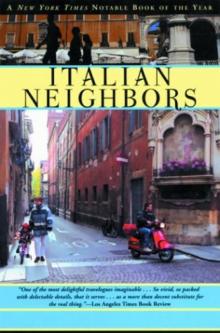 Italian Neighbors
Italian Neighbors Goodness
Goodness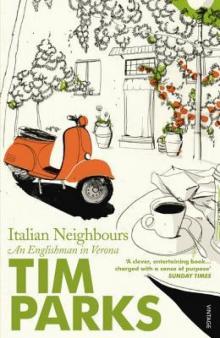 Italian Neighbours_An Englishman in Verona
Italian Neighbours_An Englishman in Verona Italian Neighbours
Italian Neighbours Juggling the Stars
Juggling the Stars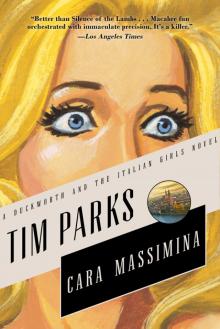 Cara Massimina
Cara Massimina Cleaver
Cleaver Where I'm Reading From
Where I'm Reading From Dreams of Rivers and Seas
Dreams of Rivers and Seas The Fighter
The Fighter In Extremis
In Extremis Painting Death
Painting Death Europa
Europa Hell and Back
Hell and Back Judge Savage
Judge Savage Thomas and Mary
Thomas and Mary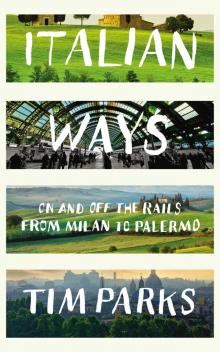 Italian Ways
Italian Ways Rapids
Rapids Mimi's Ghost
Mimi's Ghost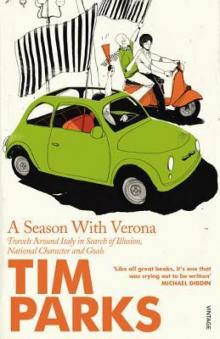 A Season With Verona
A Season With Verona Teach Us to Sit Still
Teach Us to Sit Still The Fighter_Literary Essays
The Fighter_Literary Essays Medici Money
Medici Money